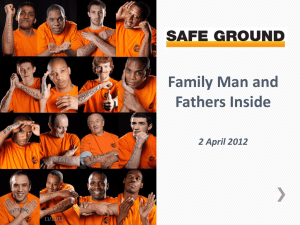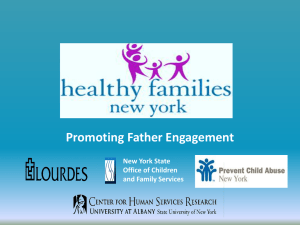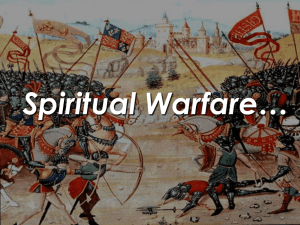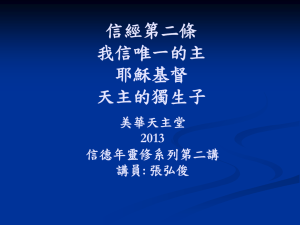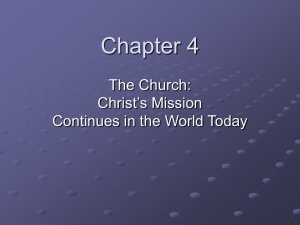Patrology - Prepare to Serve
advertisement
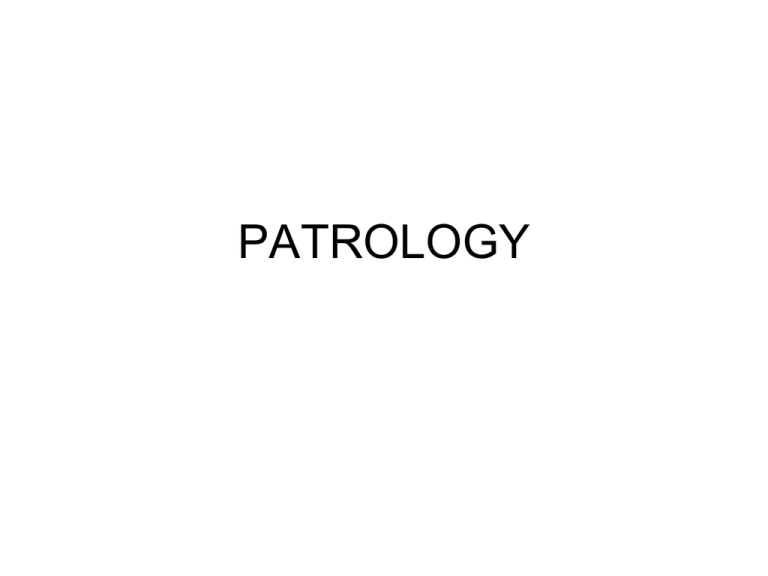
PATROLOGY • An introduction to patristic studies • This introduction is meant to present the church fathers to this generation; here we will see that the fathers were not old schools of thoughts that belonged to far old history. In contrast their teachings are more close to us now than many of the modern teachings that are farther than the teachings of Christ and the apostles of the church. These teachings of Christ are the one always new and always alive, for Christ is “the same yesterday, today and forever” • The church fathers with the bible teaching are always renewed for every generation. • They are the living extension of Christ voice and his disciples. • In every generation the fathers teachings are handed down to the next generation mingled with the experience of the living bible and faith of each one of them. • + There is that fundamental tie between the church fathers, the disciples, apostles and the Lord Himself Jesus Christ. In this connection we see the body of Christ revealed in a mystical way where the Lord Jesus is the head and the corner stone. • + The disciples • They have been commissioned by the lord Himself to go out preach and baptize on the name of the Father, the Son and The Holy Spirit. The first fruits were the 3000 in the day of Pentecost, and then many others followed from Judea, Jerusalem, Galilee and the surrounding areas where they formed the first nucleus of the church which in turn attracted all the nations from all corners of the earth. By the end of the apostolic generation, the gospel has already reached most of the existing world then. • What was their message? • It was in accordance with the Lord’s teaching Himself. Simple and comprehensive in 4 points: • 1- Reveals God’s love to sinners and all mankind. • 2- His invitation for repentance. • 3- Faith in Jesus Christ. • 4- Living according to that faith. • This simple teaching was very accommodating to the human soul for salvation. All the teachings of the fathers have revolved around the same • points. The proof of this lies in all the teachings to the catechumens who were prepared to receive baptism. • + Two major methods they relied on; first the liturgical mystical services like baptism or Eucharist. The work was accomplished by the Holy Spirit who still works till today in the church and till the end of ages. The second was the service of the word and the writings of their books. • The fathers took this talent of the apostolic tradition and kept it and entered into many heretic battles and added to it legitimate creeds that kept the faith alive till today, they defended the faith even unto death. • It is our role now to keep that treasure of their teaching alive for us and for the generations to come. • Who are the fathers? • This title was used first for the fathers of the Old Testament. Like Abraham, Isaac and Jacob. • Then in early Christianity we see the use of the term father to the teachers of the church. Also it was used for the bishops. By the fourth century the term was extended to those teachers and writers who were not bishops like what St Augustine mention St Jerome as a father even he was not a bishop. However not all church writers are considered fathers, for example Tertullian and Origen , the first is one of the great writers but he fell in the Montanan’s heresy so he is considered a great writer but not a father. Also Origen despite his great contributions to the church he fell in few mistakes kept him as a writer and not a father. • Patrology: is the study of the lives of the church fathers and teachers at the old times. From the apostolic era to around the sixth century • The first book appeared in these field was the book of st Jerome (irenemous) in 393 A.D. in his Latin book Viris Illustribus i.e. the life of the famous men in which he mainly relied on the book of history written by Josephus of Caesarea. • It is important to realize that each father had his own unique style according to his life and or circumstances of his time especially if he was facing certain problems or heresies etc. • Others were establishing new orders like monasticism. • Acceptable fathers has certain characteristics • • • • • orthodoxy holiness Church acceptance to them. Antiquity: varies among different churches; the Caledonian’s determines the end of the fathers era around the seventh or eighth century , in the west the fathers era ends by St Gregory the great (died 604 A.D) and St Theodore Seveille (reposed 636 AD). In the east it ends by St John of Damascus (reposed 749 AD). While the non Caledonian churches (Coptic, Ethiopia, Assyrian and Armenian) decided that the end of the era lies a little after the Caledonian assembly (451 AD). • The 4th and 5th. Century are considered the golden era of the fathers, during that time the church through the fathers managed to determine and explain the apostolic faith in the face of heresies. • Are there still any more fathers today? The answer to that is YES for the Holy Spirit still works in the church till today. Every generation has it’s challenges and its spiritual warfare. This always brings up the fathers and the apologetics to defend and keep the faith to the faithfuls. • Classification of the fathers • General: • The apostolic fathers: those who were in contact with the apostles during their lives. for example Clement of Rome, Ignatius of Antioch, Polycarp and Babiass • The apologetics are those who defended the faith against heathenism, critics, philosophers, early Jewish scholars. Examples of those are St Justine the martyr, Ithenagoros, and Ireneus. • The teachers of the church: St Athanasius of Alexandria, St Cyril the great St Basil, St Gregory the theologos and St John Chrysostom (from the east). St Cyprian, St Jerome, St Augustine (from the west). • The confessors are those who suffered for the faith: as St Dioscorous of Egypt and St Severus of Antioch. • The fathers of monasticism are those who established the pure and genuine faith in combination with the ascetic life : like St Antony, St • • • • • • • • • • Makari, St Bachomious, and all the late fathers of the desert that came after. There is also the classification by the language they wrote with. For example; the Latin fathers, the Greek, the Coptic fathers, the Armenian fathers the Assyrian fathers. However the largest portions of the father’s writings were either in Greek or Latin. The most reverend fathers by our Copt orthodox church who wrote in Greek are St Athanasius the twentieth pop St Basil the great archbishop of the Cappadocian Caesarea St Gregory the theologos Bishop of zasima St John Chrysostom patriarch of Constantinople St Cyril of Alexandria the 24th pope St Dioscorous the 25th pope St Severus of Antioch pope of Antioch. • Another classifications are by the date i.e: • The history of their writings • The first era was the first 3 centuries; this time is very important since these writers were the closest in time to the founders of the church i.e. the apostles. Especially teachings on the trinity, incarnation, the church infra structure with it’s laws and original cannons. • The second era between 300 and 430 A.D. this extends from st Athanasius to the repose of St Cyril the great in the east and St Augustine in the west. • 300 to 360 A.D was concentrating on the subject of the Trinity and determining the orthodox faith. • • From 360 to 430 A.D The expansion and explanation of the previous era teachings. The most popular writings were those of St Cyril the great. • From 430 AD to the 7th century. • The first part was Christology around the nature of Christ after establishing the dogma of the trinity. It extended from the assembly of Ephesus 431AD to Caledonia to second Constantinople 553 AD. These era had those fathers that were persecuted and suffered for the faith like St Discorous and St Severus of Antioch. • Examples of some Books of early Christianity. • The didascalia • 1883 published by Phelitheos bishop of Nicomedia from a Greek manuscript dated 1057 and was kept in Jerusalem • The title of the book was the teaching of the12 apostles” • The shepherd by Hermes • Written by Hermes the brother of Bio (9th bishop of Rome0 • It is an apocalyptic book of 5 visions, 10 commandments and 10 parables • The second letter of Clement: undetermined if it is written by St Clement of Rome or other writer. Written in the first half of the second century, and was very popular in the Assyrian church. • The heart of this letter revolves around an invitation to repentance and living a holy life after baptism • The letter of Barnaba • Written between the year 70 and 138 • The core of the letter is “the new law of our lord Jesus Christ” (as opposed to the law of Old Testament) • The major books about the fathers • -The Benedict father wrote one of the early collections of the fathers. • - The abbe migne • 217 volumes of the Latin fathers and 161 volume of the patrologia graeca • -patrologia syriaca • -patrologia orientalis • -library of the fathers, pusey-keble-newman oxford 45 volumes (1838-1888 AD) • -ante Nicene and post Nicene. About 38 volumes



